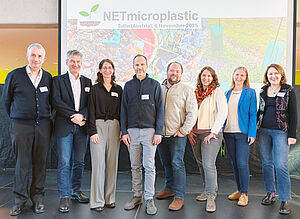On 6 November 2025, the NETmicroplastic Conference & Mini-Fair at AIT in Tulln brought together experts from science, agriculture, industry and public administration. A keynote, specialist sessions, an interactive stakeholder tour and a panel discussion shed light on sources of microplastics in soils, risks and practical countermeasures – from agricultural applications and fertilisers to compostable materials.
Plastics: benefits, limits, consequences
At the center was the question of where plastics are agronomically useful, such as for soil warming and weed control, and where biodegradable alternatives, e.g. for short periods of use, or take-back concepts are necessary. Data from European field studies and surveys show: a considerable share of inputs arises via fertilisers such as sewage sludge, compost, farm manures, while a good third comes from carelessly discarded litter. The connection between biowaste-bin collection systems, composting and plastic inputs was also addressed.
Facts from research and the field
In the keynote, Christian Lott (HYDRA Marine Sciences) outlined sources, regulations and solution approaches to microplastics in agricultural soils. Contributions by Ildikó Heim (FiBL Austria), Amila Abeynayaka (TU Denmark) and Ferran Martí Ferrer (Aimplas) ranged from surveys of farmers and a farm-based decision-support tool to experiences with biodegradable mulching films. The second session, with Melanie Brait & Florian Brunner (Compost & Biogas Association), Julia Möller (WUR) and Gabriel Gerner (ZHAW), analysed microplastics in organic waste streams, composting processes and regulatory aspects of biodegradable plastics.
“Plastics are not problematic per se – what matters are the area of application, duration and circular management. Where retrieval cannot be reliably ensured, products should be tested for proven biodegradability in the field; at the same time, farmers need clear product information and information on handling with standard equipment,” says Claudia Preininger, AIT Bioresources expert and coordinator of NETmicroplastic. This also reflects the tenor of the panel discussion, moderated by Martin Kainz, University for Continuing Education Krems, which linked practical knowledge from arable and viticulture with policy and authority perspectives.
Innovation along the value chain
At the mini-fair, Green Legacy, Lenzing, Lactips, AGRANA RIC, ECHO Instruments, RECENDT and the “bündnis mikroplastikfrei” presented innovative developments in the areas of measurement and analytics technologies as well as new materials.
The network recommends testing the biodegradability of plastic products under real field conditions, improved product labelling and practice-oriented information for businesses.
At the same time, the public should be made more aware of the connection between waste disposal via the biowaste bin, the challenges of plastic separation in composting plants and the input of non-separable plastic and/or microplastics into soils via compost. The aim is to significantly reduce avoidable inputs into the soil – particularly through littering.
Link: www.net-microplastic.eu





